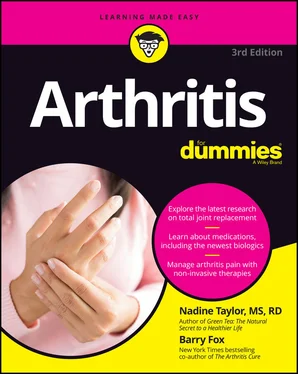Barry Fox - Arthritis For Dummies
Здесь есть возможность читать онлайн «Barry Fox - Arthritis For Dummies» — ознакомительный отрывок электронной книги совершенно бесплатно, а после прочтения отрывка купить полную версию. В некоторых случаях можно слушать аудио, скачать через торрент в формате fb2 и присутствует краткое содержание. Жанр: unrecognised, на английском языке. Описание произведения, (предисловие) а так же отзывы посетителей доступны на портале библиотеки ЛибКат.
- Название:Arthritis For Dummies
- Автор:
- Жанр:
- Год:неизвестен
- ISBN:нет данных
- Рейтинг книги:3 / 5. Голосов: 1
-
Избранное:Добавить в избранное
- Отзывы:
-
Ваша оценка:
- 60
- 1
- 2
- 3
- 4
- 5
Arthritis For Dummies: краткое содержание, описание и аннотация
Предлагаем к чтению аннотацию, описание, краткое содержание или предисловие (зависит от того, что написал сам автор книги «Arthritis For Dummies»). Если вы не нашли необходимую информацию о книге — напишите в комментариях, мы постараемся отыскать её.
Arthritis For Dummies
Arthritis For Dummies
Arthritis For Dummies — читать онлайн ознакомительный отрывок
Ниже представлен текст книги, разбитый по страницам. Система сохранения места последней прочитанной страницы, позволяет с удобством читать онлайн бесплатно книгу «Arthritis For Dummies», без необходимости каждый раз заново искать на чём Вы остановились. Поставьте закладку, и сможете в любой момент перейти на страницу, на которой закончили чтение.
Интервал:
Закладка:
The following include conditions in which arthritis is the major part of the syndrome and the primary disease process:
Ankylosing spondylitis (AS): A chronic inflammation of the spine, this disease can cause the vertebrae to grow together, making the spine rigid. Although the cause is unknown, heredity seems to be a factor.
Gout: This “regal” form of arthritis is caused by the build-up of a substance called uric acid, which forms sharp crystals that are deposited in the joint. These needlelike crystals cause inflammation leading to severe pain and are most commonly found in the knees, the wrists, and the “bunion” joint of the big toe. Genetic factors, conditions such as high blood pressure, kidney disease, and obesity, a diet high in animal purines, alcohol consumption, and certain drugs may cause gout.
Infectious arthritis: Bacteria, viruses, or fungi that enter the body can affect the joints, causing fever, inflammation, and loss of joint function.
Juvenile idiopathic arthritis (JIA): Formerly known as juvenile rheumatoid arthritis, this is a catchall term for the different kinds of arthritis that strike children under the age of 16. Pain or swelling in the shoulders, elbows, knees, ankles, or toes; chills; a reappearing fever; and sometimes a body rash are typical symptoms of various kinds of JIA. The cause is unknown.
Osteoarthritis (OA): In this, the most common type of arthritis, the cartilage breaks down, exposing bone ends and allowing them to rub together. The result can be pain, stiffness, loss of movement, and sometimes swelling. Osteoarthritis is most often found in the weight-bearing joints, such as the hips, knees, ankles, and spine, but it can also affect the fingers. It may be the result of trauma, metabolic conditions, obesity, heredity, or other factors.
Pseudogout: Like gout, pseudogout is caused by the deposition of crystals into the joint, but instead of uric acid crystals, they’re made from calcium pyrophosphate. Pain, swelling, and sometimes the destruction of cartilage can result. Note: This deposition of calcium pyrophosphate crystals is not related to the dietary intake of calcium.
Psoriatic arthritis: This form of arthritis occurs in people who have the autoimmune skin condition called psoriasis, which causes scaly, red, rough patches on the neck, elbows, and knees, as well as nail changes. Psoriatic arthritis can affect joints anywhere in the body, including the spine, the fingers, and the toes, which can swell up like little sausages.
Rheumatoid arthritis (RA): An autoimmune disease, RA causes the body to mistakenly attack its own joints, causing inflammation and swelling of the tissues surrounding the joint, resulting in joint pain and swelling. Over time, there can be a loss of cartilage, causing shrinkage of the space between the bone ends, which increases pain and decreases mobility; irreversible joint deformity can even occur. RA often affects the same joint on both sides of the body (for example, both wrists) and is two to three times more likely to strike women compared to men. (For more on this, see the sidebar “ Why are Women More Likely to Get Arthritis,” near the end of the chapter.)
ARTHRITIS BY THE NUMBERS
Arthritis affects a surprisingly large number of us, as you can see by the following numbers:
Over 58 million adult Americans currently suffer from arthritis, or 1 in 4 of us. It is the leading cause of disability among adults in the U.S.
Women are more likely than men to get arthritis, which currently affects one in four women compared to one in five men. They are also far more likely to develop rheumatoid arthritis than men and to experience worse pain.
By 2040, it’s projected that that the number of U.S. adults with doctor-diagnosed arthritis will have increased by 49 percent to an estimated 78.4 million (nearly 26 percent of the population).
In 2013, the total national cost of treating arthritis was $140 billion. It is the reason behind more than 100 million outpatient visits and 6.6 million hospitalizations annually.
Osteoarthritis is by far the most common type of arthritis, affecting more than 30 million Americans, most of whom develop the disease after the age of 45.
Gout is the second most prevalent form of arthritis in the U.S., affecting 8.3 million sufferers, followed by rheumatoid arthritis at 1.3 million. Sjögren’s afflicts 1-4 million and fibromyalgia afflicts 4 million, but not all of them will have arthritis.
About 1.5 million American adults have rheumatoid arthritis (RA), which mostly strikes women, while gout tends to favor men.
Some 1 in 1,000 U.S. children under the age of 17 have some form of joint disease, which translates to an astonishing 300,000! Of those, 50,000 have juvenile idiopathic arthritis (JIA).
Arthritis most often strikes in the knees and the hips, most likely because both are weight-bearing joints and can easily be injured. To fight the pain and disability that can result, there are about 500,000 hip replacements and 750,000 knee replacements performed in the U.S. every year.
Classifying arthritis as a “major player”
In the following conditions, arthritis is present and is usually a major part of the syndrome, but is not the primary disease process:
Lyme disease: Caused by a certain type of bacteria transmitted to humans via tick bites, Lyme disease brings about fever, a distinctive red skin lesion in the shape of a bull’s-eye, problems with the nerves and/or heart, and arthritis. Antibiotics are the treatment of choice for this disease.
Reactive arthritis: An inflammation of the joints, reactive arthritis strikes along with or shortly after the onset of an infection, often one that is intestinal or sexually-transmitted. The three problems generally associated with reactive arthritis are arthritis, conjunctivitis (inflammation of the eyelid’s lining), and urethritis (inflammation of the urethra).
Scleroderma: The word scleroderma means hard skin. This is a rare autoimmune condition that involves an attack on tiny blood vessels in many places in the body, and overproduction of collagen in places it doesn’t belong. The skin and other organs can stiffen. Joints can become inflamed, and tightness of the skin overlying the joints can make them even harder to move. An autoimmune disease, scleroderma usually attacks adults rather than children.
Systemic lupus erythematosus: This is yet another disease caused by an immune system gone wrong. In lupus, the body attacks its own tissue, causing inflammation, joint pain, stiffness, permanent damage to the joints, and exhaustion. Although lupus most often affects women of child-bearing age, it does strike some men and can occur at nearly any age, including childhood and post-menopause.
Describing arthritis as a “minor player”
In these conditions, arthritis may appear, but is a minor part of the syndrome.
Bursitis and tendonitis: Caused by overusing or injuring a joint, bursitis is the inflammation of the fibrous sac that cushions the tendons. Tendonitis is the irritation of the tendons, which attach the muscles to the bones.
Paget’s disease: With Paget’s disease, the breakdown and rebuilding of bone speeds up. The resulting bone is larger but also softer and weaker, making it more likely to fracture. These weakened and deformed bones cause arthritis to develop in their respective joints, which typically include those of the hip, skull, spine, knee, and ankle. The cause is unknown.
Polymyalgia rheumatica (PMR): With this condition, severe stiffness can suddenly strike in the lower back, hips, shoulders, and neck, making it difficult even to get out of bed. The pain is similar to that of RA, often without evidence of any active arthritis. PMR can occur by itself or together with a life-threatening inflammation of the blood vessels called giant cell arteritis (GCA). Symptoms of GCA can occur before, after, or at the same time as PMR, and include headaches, scalp tenderness, hearing problems, vision loss or changes, and tongue or jaw pain after prolonged chewing.HYPERSENSITIVE FINGERS AND TOESPrompted by arterial blood vessel spasm, Raynaud’s phenomenon is a condition that can make the fingers, toes, nose, or nipples extremely sensitive to cold and to emotional upsets, turning them blue/violet or white in color. It sometimes occurs in conjunction with (or as a result of) other arthritis-related conditions including lupus, scleroderma, RA, and myositis, but can also be caused by repetitive trauma or injuries to the nerves of the hands or feet, smoking, certain medications, or chemical exposure. Typical attacks of Raynaud’s phenomenon include tingling, numbness and whitening of the fingers (without affecting the thumb), and pain or redness when blood circulation returns.There's no single blood test for Raynaud's: most doctors diagnose the disease based on signs and symptoms. Treatment generally involves wearing gloves, socks, and hats to maintain total body warmth, and avoiding workplace triggers, such as vibrating tools, freezers, and exposure to air conditioning vents. In severe cases of Raynaud’s, doctors prescribe medication to dilate the blood vessels. See Chapter 5for more on Raynaud’s phenomenon.
Читать дальшеИнтервал:
Закладка:
Похожие книги на «Arthritis For Dummies»
Представляем Вашему вниманию похожие книги на «Arthritis For Dummies» списком для выбора. Мы отобрали схожую по названию и смыслу литературу в надежде предоставить читателям больше вариантов отыскать новые, интересные, ещё непрочитанные произведения.
Обсуждение, отзывы о книге «Arthritis For Dummies» и просто собственные мнения читателей. Оставьте ваши комментарии, напишите, что Вы думаете о произведении, его смысле или главных героях. Укажите что конкретно понравилось, а что нет, и почему Вы так считаете.












